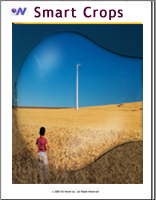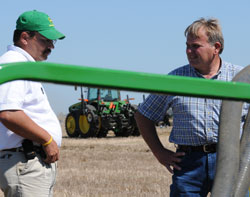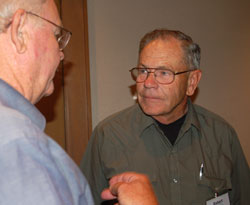 Precision applications are showing up in all kinds of agricultural applications. Here’s a new report from On World about utilizing wireless sensing solutions to manage water usage.
Precision applications are showing up in all kinds of agricultural applications. Here’s a new report from On World about utilizing wireless sensing solutions to manage water usage.
Facing a water shortage crisis and the demands of a global economy, farmers are turning to wireless sensing solutions to save labor costs, increase yields, improve quality, and conserve water, according to a recent report by ON World. The emergence of standards based short range radios, advanced network protocols, and the availability of low cost backhaul technologies, have made wireless sensor systems an affordable competitive advantage for farmers/growers.
“As drought conditions worsen in areas such as California and Australia, vendors can barely keep up with the demand,” according to Mareca Hatler, ON World’s director of research. Smart irrigation systems can save 30% of a farm’s water bill while increasing production yields by 20%.
ON World’s recently published report, “Wireless Sensor Networks for Smart Crops” analyzes the drivers and return on investment for adopting wireless crop monitoring solutions for several crop types. It includes global and US Total Potential market size forecasts, in-depth profiles on the top six wireless crop monitoring vendors, analysis on WSN technologies such as IEEE802.15.4 and mesh networking including several power and performance simulations using the wsnSimulator™.


 “All of our computerized control panels will be GPS Ready, which means producers will be able to easily take advantage of the benefits of GPS technology,” Valley Irrigation’s Rich Panowicz says. “Producers need to be able to manage precision application of water and fertilizers. GPS Ready control panels for center pivots and linears can help producers do just that. With the high costs of fuel, fertilizer, water and other inputs, it’s important for producers to incorporate these tools that will help their bottom line.”
“All of our computerized control panels will be GPS Ready, which means producers will be able to easily take advantage of the benefits of GPS technology,” Valley Irrigation’s Rich Panowicz says. “Producers need to be able to manage precision application of water and fertilizers. GPS Ready control panels for center pivots and linears can help producers do just that. With the high costs of fuel, fertilizer, water and other inputs, it’s important for producers to incorporate these tools that will help their bottom line.” The Farm Science Review is taking place in London, OH and I got to attend the precision ag field demos yesterday and found John Deere on the job.
The Farm Science Review is taking place in London, OH and I got to attend the precision ag field demos yesterday and found John Deere on the job. Measuring progress is key to determining which farming techniques are more profitable than others for growers. Clay Mitchell, a farmer in NE Iowa says aligned-farming is a precision farming technique that allows growers to measure their progress, particularly compared to angled-farming.
Measuring progress is key to determining which farming techniques are more profitable than others for growers. Clay Mitchell, a farmer in NE Iowa says aligned-farming is a precision farming technique that allows growers to measure their progress, particularly compared to angled-farming. Specialized farming practices paired with specialized farming technology can mean “special” results for farmers if you ask Robert Klein. Robert is an Extension Cropping Systems Specialist with the University of Nebraska in North Platte. He says when it comes to seeding and planting plots for crop performance evaluation, using GPS-RTK Auto Steering technology with skip-row planting methods can boost yields.
Specialized farming practices paired with specialized farming technology can mean “special” results for farmers if you ask Robert Klein. Robert is an Extension Cropping Systems Specialist with the University of Nebraska in North Platte. He says when it comes to seeding and planting plots for crop performance evaluation, using GPS-RTK Auto Steering technology with skip-row planting methods can boost yields. Pioneer is offering a new, free service that it says can give farmers more: more information and more uses for that information. Pioneer Hi-Bred’s
Pioneer is offering a new, free service that it says can give farmers more: more information and more uses for that information. Pioneer Hi-Bred’s  Farmers wanting to ease into precision technology have new equipment options from John Deere. The ag machinery company has unveiled three n
Farmers wanting to ease into precision technology have new equipment options from John Deere. The ag machinery company has unveiled three n If growers are looking for a new receiver for their GreenStar systems, John Deere’s new StarFire 300 should offer them an economical option. The satellite WAAS receiver boasts 13-inch accuracy and mounts easily with a magnet.
If growers are looking for a new receiver for their GreenStar systems, John Deere’s new StarFire 300 should offer them an economical option. The satellite WAAS receiver boasts 13-inch accuracy and mounts easily with a magnet. AutoTrac guidance is no longer just for tractors. Farmers can now use assisted steering technology on combines.
AutoTrac guidance is no longer just for tractors. Farmers can now use assisted steering technology on combines. 